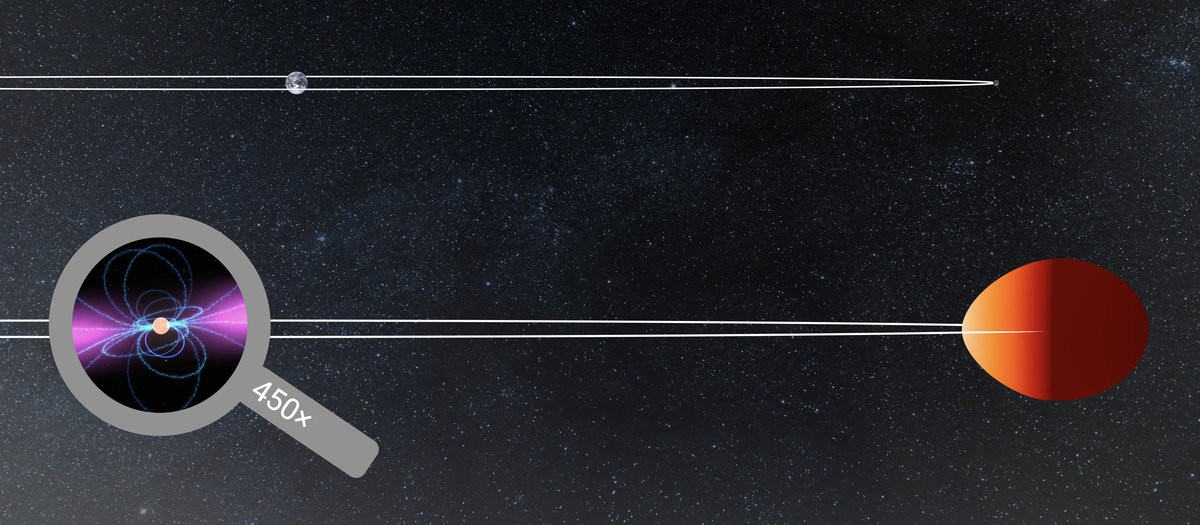Oct 23 2020
An international group of researchers has detected a galactic mystery source of gamma rays after more than 20 decades. The newly identified gamma-ray source is a heavy neutron star that is being orbited by a very low mass companion.
 Illustration of the binary star system with pulsar (bottom) in comparison to the Earth-Moon system (top). Image Credit: Knispel/Clark/Max Planck Institute for Gravitational Physics/NASA.
Illustration of the binary star system with pulsar (bottom) in comparison to the Earth-Moon system (top). Image Credit: Knispel/Clark/Max Planck Institute for Gravitational Physics/NASA.
The researchers used innovative data analysis methods that run on approximately 10,000 graphics cards in Einstein@Home—the distributed citizen science project—and eventually detected the neutron star by its commonly pulsating gamma rays in a deep quest for data from the Fermi satellite of NASA. Unexpectedly, the researchers found that the neutron star is fully invisible in radio waves.
The binary system has set new records and was defined with an observing campaign across the electromagnetic spectrum.
In addition, the neutron star rotates around its own axis at over 30,000 rates per minute (rpm), rendering it one of the fastest rotating stars. Moreover, its magnetic field—which is generally very strong in neutron stars—is extremely weak.
From 2014 onwards, astronomical observations had allowed scientists to establish the properties of the orbits of the binary star.
That a neutron star is behind the gamma-ray source known since 1999 was considered probable since 2009. In 2014 after observations of the system with optical and X-ray telescopes it became clear that this is a very tight binary system. But all searches for the neutron star in it have so far been in vain.
Dr Colin Clark, Study Co-Author, Jodrell Bank Centre for Astrophysics, The University of Manchester
To explicitly demonstrate the existence of a neutron star, their typical pulsations should be detected in addition to detecting its gamma rays and radio waves. This regular flashing, analogous to the periodic twinkling of a remotely located lighthouse, is caused by the spin of the neutron star. The neutron star is subsequently referred to as a gamma-ray or radio pulsar, respectively.
This was the first Spider pulsar to be made through the collaboration between Jodrell Bank and the Albert Einstein Institute, but there are several more candidate Spider binaries just like this one. Our group within Jodrell Bank is monitoring these closely with optical telescopes to pin down their orbital periods with the precision required for gamma-ray pulsation searches to conclusively identify them. We are hopeful that this is the first of many such discoveries.
Dr Colin Clark, Study Co-Author, Jodrell Bank Centre for Astrophysics, The University of Manchester
Dr. Clark continued, “In binary systems like the one we have now discovered, pulsars are known as ‘black widows’ because, like spiders of the same name, they eat their partners, so to speak,. The pulsar vaporises its companion with its radiation and a particle wind, filling the star system with plasma that is impenetrable to radio waves.”
Recently published in The Astrophysical Journal Letters, the latest study was performed because of the computing power assistance of 10,000 volunteers. The global collaboration on the large computing power of Einstein@Home—the citizen science project—was an innovative data analysis method to detect the weak gamma-ray pulsations of the neutron star in the data obtained from the Fermi Space Telescope belonging to NASA.
The volunteers contributed idle compute cycles on the graphics cards (GPUs) of their PCs to Einstein@Home. Within a couple of weeks, the researchers made a finding that would have taken many years of computing time on a traditional computer.
The binary star system and the neutron star at its heart, now known as PSR J1653-0158, set new records. We have discovered the galactic dance of a super heavyweight with a flyweight. At slightly more than twice the mass of our Sun, the neutron star is extraordinarily heavy. Its companion has about six times the density of lead, but only about 1% the mass of our Sun. This ‘odd couple’ orbits every 75 minutes, more quickly than all known comparable binaries.
Lars Nieder, Study First Author and PhD Student, Albert Einstein Institute
After detecting the gamma-ray pulsar, the researchers looked for its radio waves. However, they did not find any trace, despite using the world’s largest and most sensitive radio telescopes, such as the Lovell Telescope from Jodrell Bank. Therefore, PSR J1653-0158 becomes the second rapidly rotating gamma-ray pulsar from which no radio waves are visible.
Two viable explanations exist—either the pulsar does not send any radio waves towards the Earth, or, more probably, the plasma cloud surrounds the binary star system so completely that radio waves do not reach the Earth.
As an additional step, the team looked for data from both the first and second observing runs of the Advanced LIGO detectors for potential gravitational waves that would be produced by the neutron star if it were slightly distorted. Again, the quest proved to be ineffective.
Journal Reference:
Nieder, L., et al. (2020) Discovery of a Gamma-Ray Black Widow Pulsar by GPU-accelerated Einstein@Home. The Astrophysical Journal Letters. doi.org/10.3847/2041-8213/abbc02